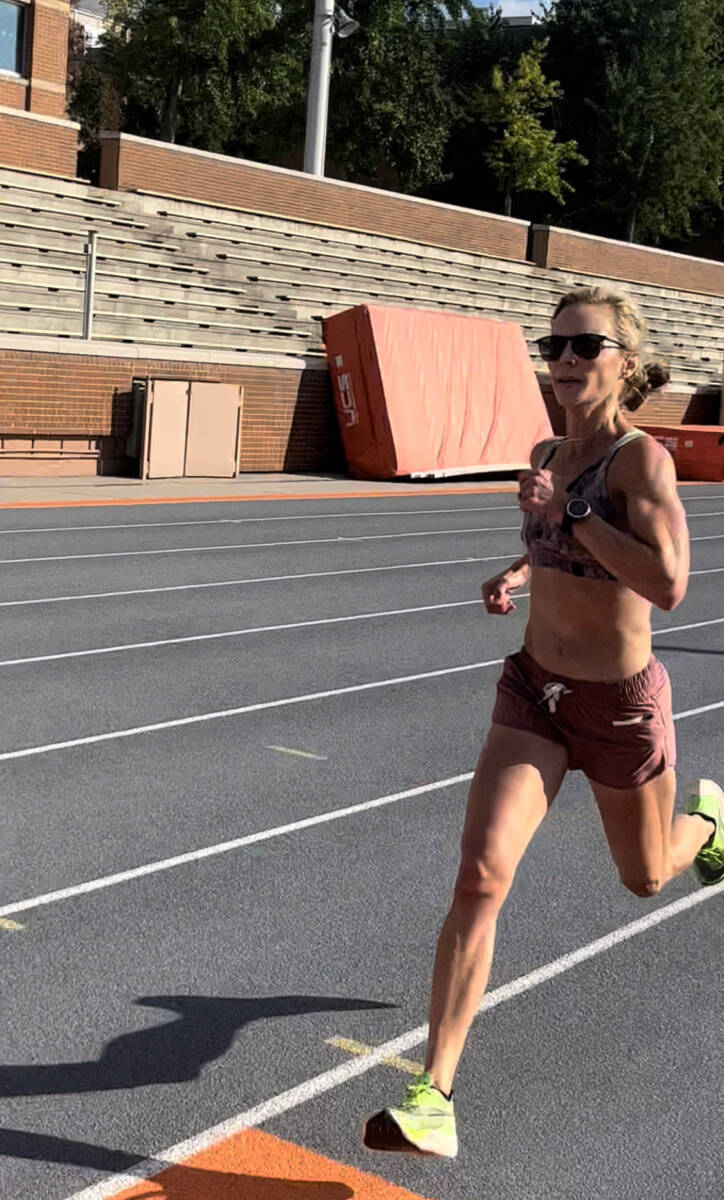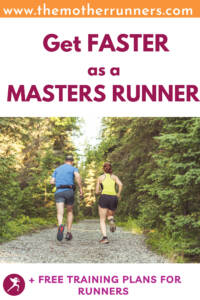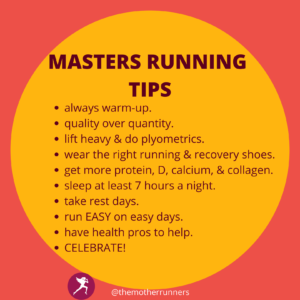Research indicates that runners start to get slower around age 40 due to changes such as loss in muscle mass and mobility. But training smarter by including strength training with heavy weights and plyometrics, altering our diets, and focusing on recovering can help master’s runners get faster or keep going as they age. Read more for expert tips from certified running coaches such as myself (also a master’s runner).

I’ve been officially a master’s runner for more than a year now. And guess what? I have plans to be faster than ever. I have goals of trying to run a sub-5-minute mile and shaving lots of time off my marathon PR to get me close to qualifying for the Olympic Trials with a 2:36:59 marathon time. How? With these masters running tips.
If I’m going to train at the intensity that I need to get FASTER as a MASTERS (there’s a reason these two words rhyme!), then I need to train smart and pay attention to the little things. I refuse to let my age slow me down! Naysayers be damned,

The main theme here is, that when we are young, we can get away with a lot when it comes to pushing our bodies. We can roll out of bed and go sprint intervals and feel fine after, no problem. But as we get older, running after 40, 50, and beyond, we simply can’t do that.
The little things that smart runners do become more important as we age.
The little things like warming up or strength training help prevent injury and maintain our power.
I’ve battled injuries for the past couple of years, so I know firsthand the importance of these masters running tips in keeping me healthy and strong. I know what’s worth our time and what’s not.
So, I am sharing my secrets to success (so far) plus tips from experts.
Table of contents
Let’s go!
What does masters mean in running?
Masters in running simply means that you are running over the age of 40. You compete in a new category in races in which you race against those 40 and above.
What are the main differences in running between younger and older runners?
Older runners must focus more on the quality of their running than the quantity with a new focus on speed and recovery time.
Older runners must take small actions every day to counteract the natural decline of their bodies including declines in tissue elasticity, muscle mass, and mobility.
These small actions are detailed below.

Why do I run slower as I age?
You run slower as you get older because your muscles get smaller, your mobility decreases, and your bones and joints weaken.
Specifically, research indicates that we start to get slower around age 40 but it is not a large decline.
- Ages 40-69 .6-1 percent decline per year
- Ages 70-89 1.5 percent decline per year
- Ages 90-95 2.3 percent decline per year
Muscular decline:
Muscle mass decreases 3 to 8 percent per decade past the age of 30. The decline is more significant past age 60.
This negatively impacts:
- our power (explosive force)
- strength (amount of resistance in exertion),
- and endurance (how long muscles can work).
Mobility decline:
We lose elasticity and mobility which impacts our posture, gait, level of proper and fluid movement, according to Certified running coach Kaila Morgante.
Joints become more vulnerable to damage as the cartilage that lines them becomes thinner and the lubricating fluid is reduced. This means they can’t slide as smoothly and become stiffer. We can’t access full range to tone the muscles surrounding them which reduces our strength, explains Morgante.
Bone density decline:
After age 50, our bone breakdown outpaces bone formation and bone loss accelerates.
After age 50, bone breakdown (resorption) outpaces bone formation and bone loss often accelerates, particularly at the time of menopause.
Soft tissue injuries, especially in the knee and foot, and bone fractures are more common among masters runners than younger runners.
How do you get faster as a masters athlete?
But wait, you can get faster as a masters runner! It’s not all doom and gloom. Many of these declines can be counteracted through your experience, training, and nutrition (and some running gear).
If you want to get faster with age, you need to be smart and stay true to the equation that STRESS+REST=SUCCESS.
Level up your intensity AND level up your recovery.

10 Masters Running Tips to Get Faster as a Masters Runner
-
Always warm-up.
No more rolling out of bed to run. Wake up well before your run so give your body time to become alert and loose. Personally, I like to give myself an hour to drink coffee, fuel, work, and do my mobility work.
Give yourself time to do dynamic stretches, foam roll, use your massage gun, etc. Many of us have warm-ups that target our specific needs. For instance, I do toe yoga as part of mine since I tore my plantar fascia last year.
Related: How to Foam Roll
Warming up before a run takes as little as 5 minutes. But it readies the body for running by increasing blood flow and range of motion and is crucial for injury prevention and performance.
After you have warmed up, give yourself at least 10-15 minutes of easy running before picking up the pace.
My warm-up for workouts is 3 miles! It has gotten longer as I have gotten older! My body needs time to loosen up and get ready to work.
Related: Your 5-minute Running Warm-up
-
Lift heavy weights.
People are finally catching on that strength training can help you as a runner by increasing performance and preventing injury.
Lifting heavier weights and performing power moves like plyometrics becomes more beneficial as you age because your muscle mass is decreasing, explains running coach and well-known running blogger, Amanda Brooks of Run To The Finish on my podcast, The Passionate Runner.
Two times a week (or more if you can), lift heavy weights. By this, I mean, lift weights that you can only lift for a couple of reps—not 15. Do this on high-intensity run days to maximize your recovery days.
I am usually wiped from my workouts so I will aim to lift later in the day (when my kids and schedule allow) after I have refueled and recovered.
Fold in plyometric moves into your workouts. Don’t forget to work your core and do a full range of motion exercises to increase mobility.
These strength training workouts for runners can help:
- Strength Training Guide for Runners
- Kettlebell Workout for Runners
- Hamstring Exercises for Runners
- Plyometric Workout for Runners
-
Keep your easy runs EASY.
Running easy and not in the “gray zone” has been so crucial to my health as a runner—and to ANYONE’S health as a runner. What is an easy pace? Well, easy is actually a feeling and not a pace. Your easy pace will vary from day to day.
Easy should feel comfortable, conversational and controlled. Remember those 3 Cs.
For most people, this will have a heart rate below 150 but heart rate is fickle, so go by feeling. If you feel like you can run all day and are energized when you’re done, then you ran your easy pace for that day.
For most recreational runners, easy pace runs make up about 80 percent of their volume for the week.
Related: The Benefits of an Easy Running Pace
-
Fuel well and often.

If you don’t eat enough to fuel your running, you will get injured. That is fact. Fueling before longer or harder workouts is key, as well as fueling during these tougher workouts, and refueling about 30 minutes after.
I have found that I recover better by eating real food versus protein shakes and bars which don’t restock my energy and often mess with my stomach.
As we age, eating more protein, taking in collagen, and getting more vitamin D and calcium are critical for building muscle, and supporting our soft tissue, joints, and bones.
Taking supplements such as Previnex’s Joint Health PLUS, which is grounded in science, can also help protect joints and relieve pain. I can attest that it’s helped my joints and soft tissues recover quicker after hard workouts. Its blend is clinically proven to protect joint cartilage from breakdown during exercise and help with mobility in 7-10 days.
Save 15 percent off your first order with code TMR 15.
Related: Should I Be Taking Collagen?
-
Get enough sleep!
I truly believe I began my injury cycle because I wasn’t getting enough sleep. My son was young and would wake up a lot in the night. During this time, my weekly mileage doubled to 100 and my body eventually broke down.
Sleep is where the magic truly happens. It’s when your body builds itself back up from the damage you did that day to a stronger version of yourself.
Aim to get at least 7 hours a night. And if you have an opportunity to lay down during the day, do it! Sleep specialist Nicole Shallow says that even just rest or a 20-minute nap is beneficial to our recovery.
Saying you’ll sleep when you’re dead means you’ll be living a less rich life. So, try to get that shuteye as much as you can!
Related: Should You Run on No Sleep?
-
Wear the right shoes.
Make sure you are wearing the right shoes for your body and keep track of your shoe mileage. Most shoes wear out between 300 and 500 miles. My current shoes, Hoka Rincons, wear out after only 200 miles!
You can keep track using your fitness tracker data (like Strava) or by simply looking for wear and tear on the tread, sides and insides. If your legs are suddenly feeling dead or you are dealing with a “niggle” it could be time for new shoes.
Related: How Often Should I Buy New Running Shoes?
For your recovery, I strongly suggest wearing supportive shoes such as OOFOs, Hoka slides, Crocs, or Kane Revives. I live in my OOFOS, style be damned. I say in full confidence and honesty that it has made an incredible difference in my recovery. My legs feel fresher and ready to roll by the time my next run comes around. Science backs this up, too.
Related: Do Recovery Shoes Work?
-
Quality over quantity.
Just because you’re getting older doesn’t mean you should be afraid of speedwork. In fact, speedwork becomes more important as you age because if you don’t use it, you lose it.
Aim to do strides, hill strides, tempos, intervals, races, etc. Most recreational runners can do 20 percent of their weekly volume at faster paces.
Pay attention to how you feel and be open to training on a 10-day rather than 7-day wheel. Maybe you do three hard sessions over 10 days instead of 3 in a week. Maybe you cross-train more on your easy days to give your body more time to recover.
If you’ve been running for a bit of your life, you already have that mitochondrial base and capillary density, so you can focus on strengthening your neuromuscular fitness in your workouts and cardiovascular with your speed.
-
Take a rest day.
I recommend taking one full rest day a week. This is a day to foam roll, stretch, do yoga, go for a walk, or do nothing. (I do yoga most Sundays.)
I also recommend taking a rest day when you feel you need one—even if it is not on the schedule. Fearing a rest day often leads in injury so try your best to listen to your body and let it dictate when it’s time to push and when it’s time to pull back.
-
Have health professionals help you.
I have accrued a team of health professionals that have helped me through my running injury cycle and running journey. They include an amazing physical therapist, chiropractor, and now a neuromuscular massage therapist named Sandra.
I joke that Sandra is my secret weapon this marathon cycle. My body responds really well to soft tissue work and seeing her to work out my muscles after hard workouts or at the sign of a niggle has been a saving grace.
I recommend having a health professional (who knows runners!) in your back pocket at all times for maintenance and for emergencies. This will help you stay healthy and calm should you experience any aches or pains in training.
Related: How to Cope with Fear of Reinjury
-
Don’t forget to celebrate all that you are doing.
Running after 40 and running after 50, and well, running at all, is a huge accomplishment. Especially as we age, people often use it as an excuse to stop challenging themselves and growing. You are doing the opposite, in body and mind, so don’t forget to take a moment to celebrate this.
After your run, you can pause and just relish in what you did, take a selfie, share it on Instagram, tell your friends, write about it, or treat yourself to a nice massage. Whatever it is, take stock in the amazing thing you’re doing for yourself.
If you want guidance with your running at any age, check out my run coaching services. Also, be sure to check out my free training plans:
- Postpartum Training Plan
- After a Break Training Plan
- 5k Training Plans
- 10k Training Plans
- Half Marathon Training Plans
- Marathon Training Plans
- Strength Training Plan
